Welcome to the Ballroom: Part 1 Review
Over the past decade, TV programmes such as Strictly Come Dancing and its US equivalent, Dancing with the Stars, have really raised the profile and popularity of ballroom dancing in the west. Can Production I.G.’s adaptation of Welcome to the Ballroom, which takes the same idea of an amateur pairing up with a more experienced dancer and applies it to school sports anime trappings, do the same for Japan? Let’s get our dancing shoes on and find out!
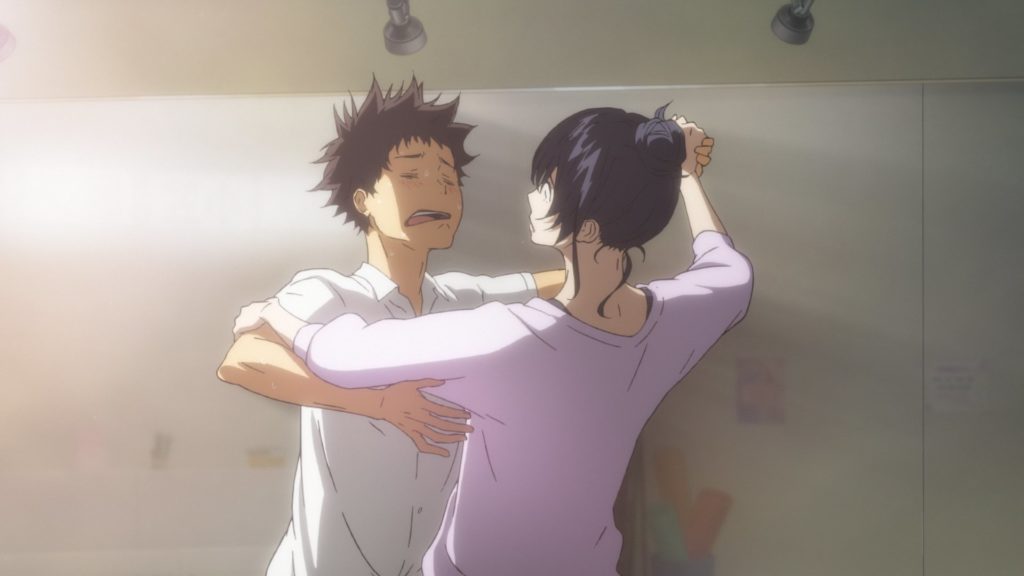
This first half of the series is all about setting up the basic premise, focusing on a select group of 15 & 16-year-old dancers vying to hit the big time. While the rest of the cast are very much established in the dancing world, our protagonist, Tatara Fujita, gets dragged into it thanks to a set of coincidences. Like most sports anime protagonists, he starts off as a bit of a loser, just drifting through life and having no idea what he wants to do. While he’s getting a lecturing from his homeroom teacher, his eye catches that of a girl, Shizuku Hanaoka, who appears to be in the same situation. Thinking they have something in common, Tatara starts taking an interest in her, but he couldn’t be further from the truth.
Walking home from school one afternoon, he catches a glimpse of her walking into a dance studio. Intrigued, he goes to take a look, but walks straight into the gang of bullies at his school who are always picking on him. Just when you think things are looking bad, a hero arrives on the scene with impeccable timing: Kaname Sengoku; professional dancing champion and a coach at the dance studio. After saving him, Sengoku drags Tatara into the studio, where Shizuku is revealed as one of the top dancers for her age and is dreaming of taking it to the world stage. While initially embarrassed by the whole thing, Tatara becomes inspired after seeing Sengoku dance and resolves to become just like his new-found idol.
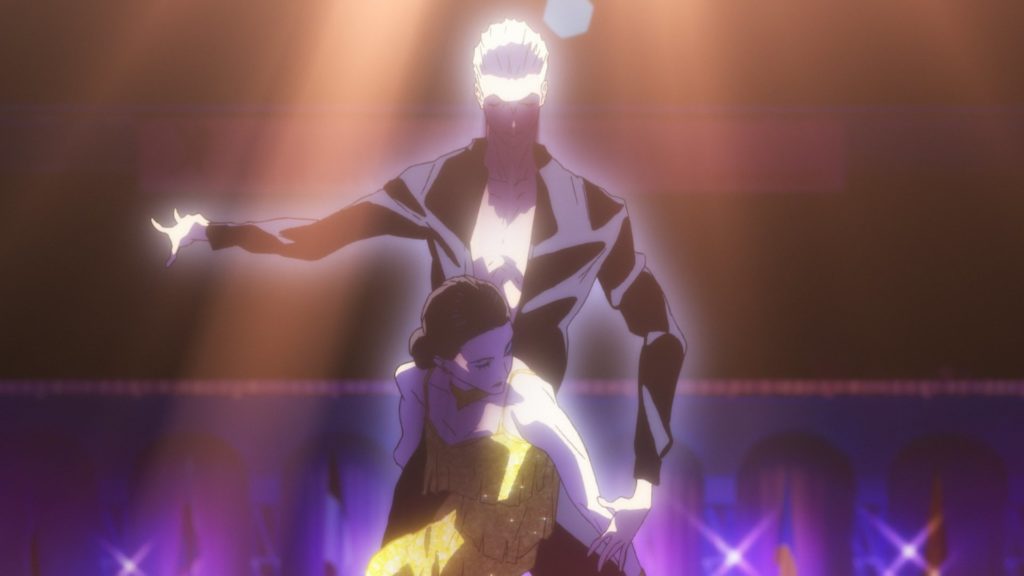
While quite a lot of sports series have the protagonist showcasing natural talent; for example, Sakamichi in Yowamushi Pedal, another wimpy character who is elevated through sport; that’s something that Tatara doesn’t have, and he starts off dancing really badly, as you’d probably expect at this early stage. The only thing he has going for him is his photographic-like memory, which enables him to pick up dance moves and routines easily just by watching someone else do them. This doesn’t automatically make him a good dancer though, and he struggles in picking up the basics through verbal teaching. While it may initially seem a bit unrealistic that he could pick up things right off the bat, it helps keep up the pace of the series, avoiding long-winded explanations of how to actually start learning to dance; while balancing things out by showing that actually, even with this ability, he’s still a terrible dancer.
As such, he is an awkward character to watch, as he piles in with overbearing enthusiasm, but continues to fail to learn the basics he truly needs to actually perform. Yet at the same time you can’t help but root for the sheer will and perseverance he shows, sticking in and not giving up. I certainly don’t know much about dance, but even I could tell that practicing the waltz’s box step for the entire night was both a stupid and incredible thing to do.
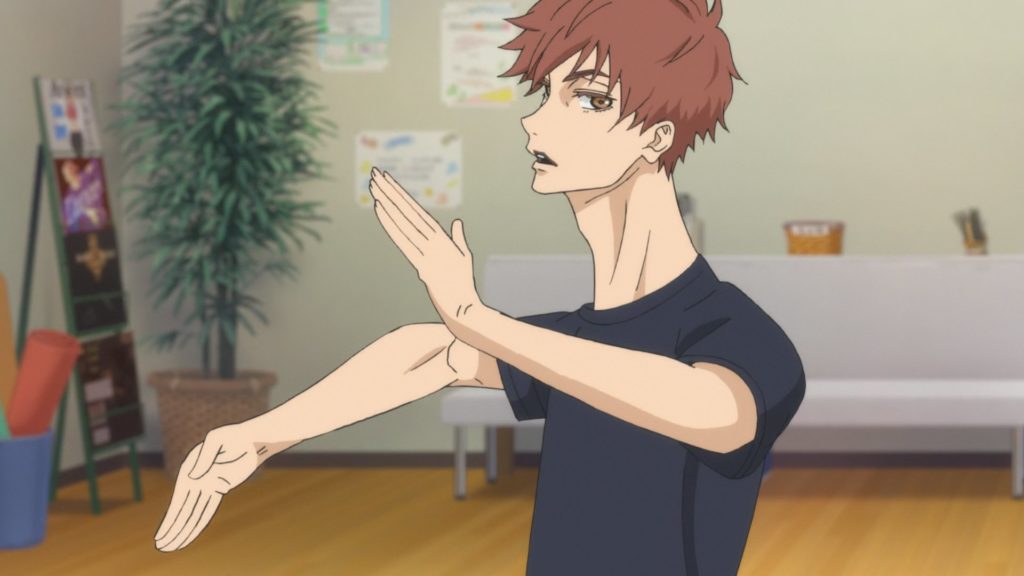
While Tatara is the main character and he learns a lot over the course of the first 12 episodes, the series takes a rather different approach to its main plot from what I would expect. Instead of being quite linear and showing him learning how to dance, and then partnering up and entering his first competition, it flings him in the deep end in order to introduce the rest of the cast; with the storyline revolving around a battle to become Shizuku’s temporary dancing partner after her long-term partner, Kiyoharu Hyodo, takes himself out with a knee injury.
Against this backdrop, Kiyoharu and Tatara begin to build a friendship and rivalry; with Kiyoharu seeing a potential for Tatara to go on to become a decent competitor, while Tatara has a mixture of awe and respect for just how skilled at, and how much effort Kiyoharu puts into dancing. After initially stepping in on Sengoku’s suggestion for a round at a big competition, Tatara feels a responsibility to be Shizuku’s partner as it was kind of his fault for going along with Sengoku’s plan and getting the couple suspended from competition. So, when Gaju Akagi gets thrown into the mix and declares he wants to be Shizuku’s dancing partner, sparks fly between them and he is set up as the main antagonist.
Gaju definitely feels like the bad guy, effectively throwing his current dancing partner, his younger sister Mako, in the dust while he mooches off to partner with Shizuku. While Tatara does want Shizuku for himself, just having him trying to take her would make him appear just as bad, so the show frames his battle with Gaju as a way of getting him and his sister back together instead.
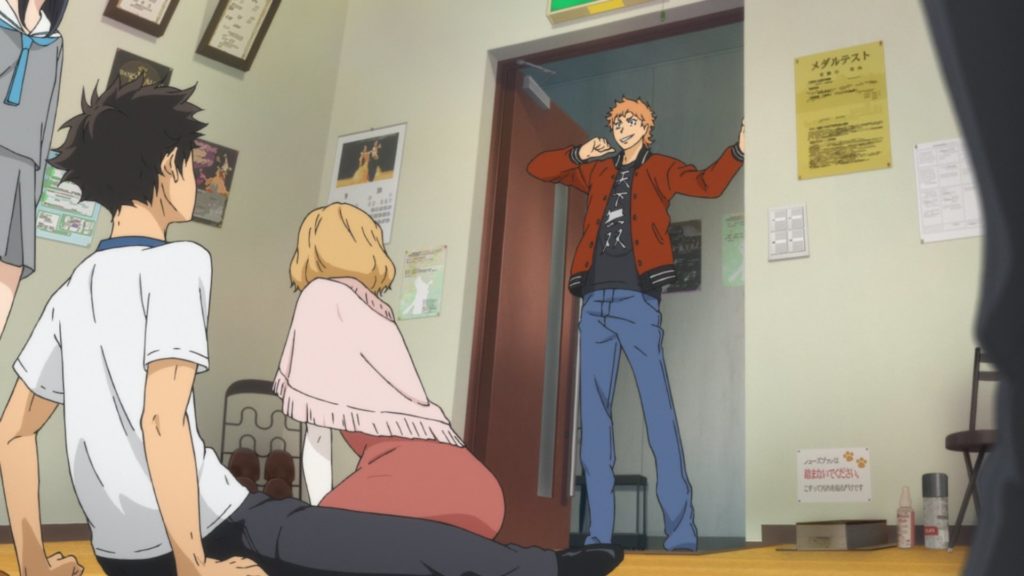
The main issue I have with this situation is that the female characters often feel like they are stuck in the middle between two guys, and for a large part of the series it devalues them no matter how strong a character or how skilled they might be. It’s not until later on when Tatara realises that the real fight is between Shizuku and Mako that it really opens up and shows them both as strong characters in their own right. This is certainly not helped by the romantic undertones the series has towards Shizuku, with Tatara having a fairly obvious crush on her, and Gaju proudly claiming that Shizuku is going to be his future wife. While ballroom dancing does require that passion and chemistry between partners, I find the series often misplaces that in a professional setting to be more sexual than it needs to be. Add in some needless fanservice and some boob jokes and it all comes off as maybe trying a bit too hard to capture the more casual or mainstream anime audience.
It does however get across its main point extremely well, that certain people may be better partnered up with others due to how different body types work when dancing. For example, Gaju is a tall, powerful young lad who needs someone of his stature to truly bring out his potential. When even Shizuku has a job reigning him in, his pairing with his sister makes no competitive sense as the difference in height and build is so great that he’s always compensating for her. Pairing Mako up with Tatara then is a better choice as they both have small, slender builds; but It’s still not quite perfect, as the pairing of two rather submissive characters lacks the chemistry that Tatara particularly needs to flourish. For the purposes of this particular contest however, it actually works out for the best.
It could be said that Tatara is used as more of a vehicle to bring out the best in the other characters, and I’d much like to see him put forward a mark for himself going forward into the second half; which we do get a quick preview of in this set due to the way the first and second halves were split between 11 and 13 episodes respectively.
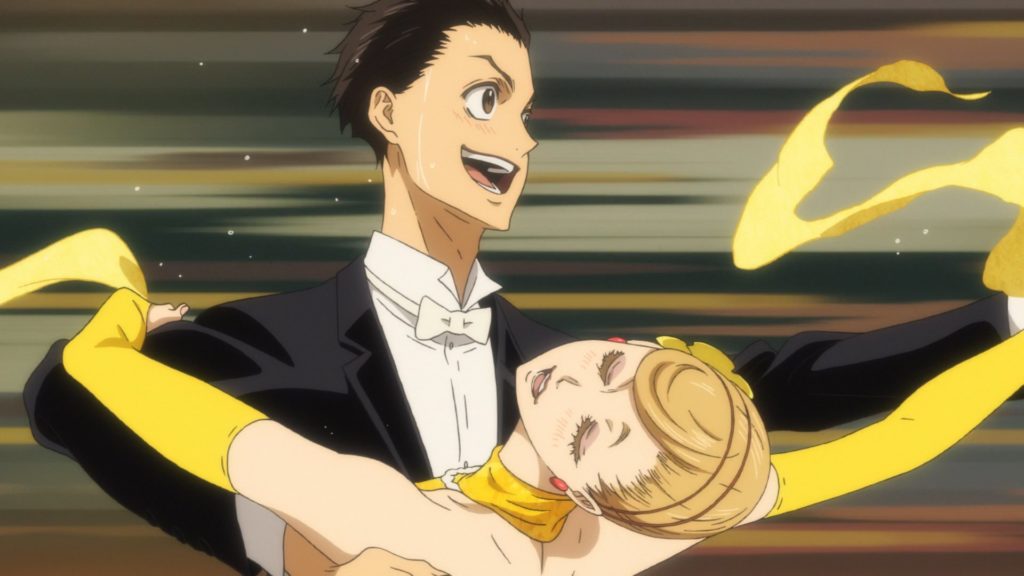
The overall art style and the character designs do look really good, with them being drawn in a very long, shojo-like style; and while characters look thin, they can still look strong and intimidating, with the guys having broad shoulders and long necks, and the girls having smooth, waterfall-like figures, both contributing to a sense of power and beauty.
The animation is generally pretty great too, and while it could have been a bit more dynamic it still does the dancing justice. In pivotal scenes it is fast, fluid and stylistic; focusing on the interpretation of the choreography, while elsewhere there is a high level of detail, from dance steps to background work. There is however some re-use of certain shots, and the overall pacing could have been a lot better. A lot of the scenes in Tensei Cup arc get dragged out to fill the available time, while I think if they had upped the pacing, it would have better reflected the high velocity nature of the sport itself.
For those new to the world of dance (like myself), rest assured that the show does a good job of tying the visuals and story together so that everything is easy to understand. You don’t specifically need to know your tango from your quickstep to enjoy the spectacle, and anything that is necessary doesn’t need five minutes of exposition for you to get it; for example, the flower and frame is easily visualised with a framed painting of a flower.
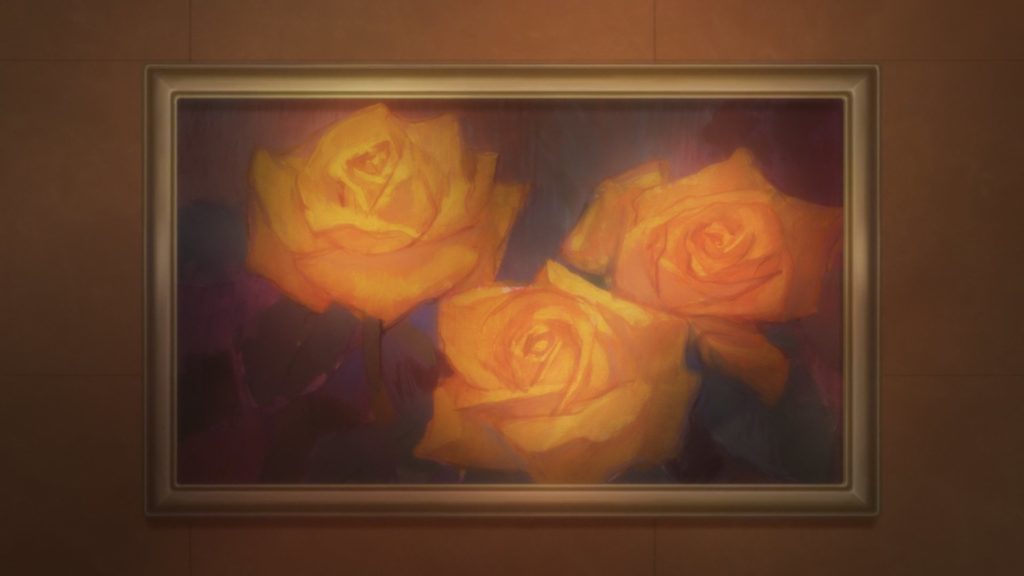
The show’s soundtrack is composed by Yuki Hayashi, who you’ll surely recognise from My Hero Academia and Haikyuu!. While it really delivers with some tense tracks and uses music that does go well with the dances, it’s a little bit inconsistent when it comes to the actual application. Instead of us as viewers hearing the music that is playing for the dance for example, it’ll sometimes keep using a specific piece that was running in the background before it started. I’m not that familiar with what music is used for what dance anyway, so if any of these are real pieces, I couldn’t tell but I do think in terms of realism and immersion it does take a little bit away from the experience.
Anime Limited’s release of this series feels a little bit bare-bones and unpolished for a collector’s edition. While we get the typical physical bonuses, with a chipboard art box, art cards, poster and booklet, all we have on the discs is the first 12 episodes of the series in subtitle only format. There are no audio options, no textless credits and no trailers, all of which you’d normally expect to have on a bog-standard release.
Personally, I’m fine with a subtitle only release, and the Japanese voice cast do a great job and fit their characters well. This is yet another anime with my favourite voice actress, Sumire Morohoshi, in it, so I’ve found myself becoming particularly attached to Mako. Other big names include Toshiyuki Morikawa (Sword Art Online’s Kikuoka) as Sengoku and Ayane Sakura (My Hero Academia’s Uraraka) as Shizuku. I am happy that the subtitles are fine and readable, after taking issue with the subtitles on many of the authors by Anime Limited’s French division for being extremely hard to read. I will note however that there does seem to be an audio glitch at the end of most episodes where it sounds like it starts to play the ending theme again but suddenly cuts out, which seems to again be just a case of the release lacking a bit of polish.
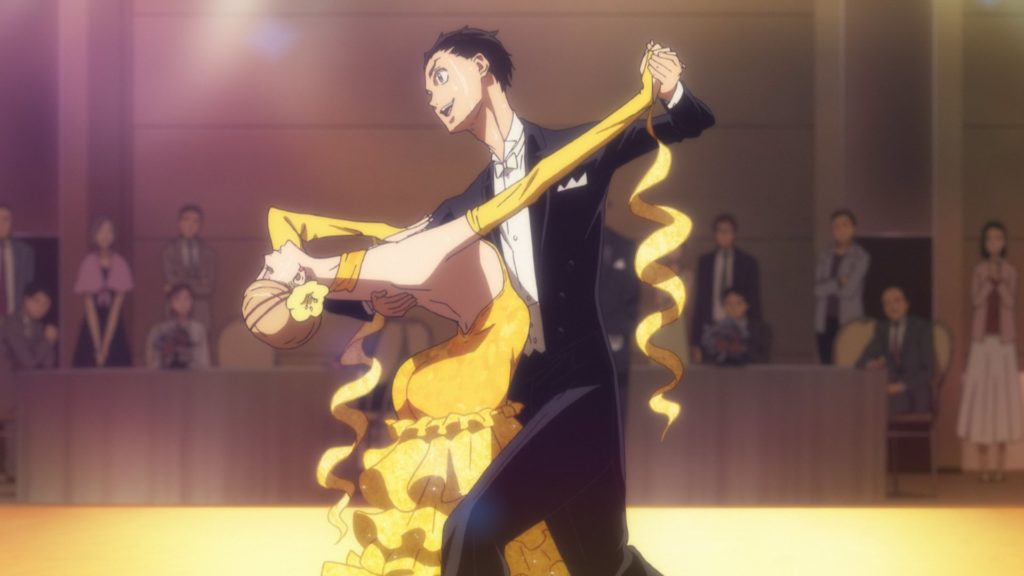
The first part of Welcome to the Ballroom is a well put together sports anime that gets down both the character drama and the spectacle of the dancing. The plot takes its own direction while keeping some common elements from other sports anime, producing a tight and tense first half of the series with a great art style and superb character design. While it’s a shame the release is very bare-bones, the show itself is one that anyone can have a lot of fun with.


